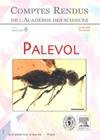Between two worlds: Cova Eirós and the Middle-Upper Palaeolithic transition in NW Iberia
IF 1.3
4区 地球科学
Q3 PALEONTOLOGY
引用次数: 2
Abstract
Iberia, a natural cul-de-sac peninsula, plays a major role in the study of the Neanderthals demise and its eventual relationship with the spread of Anatomically Modern Humans (AMH) in Europe. The site of Cova Eirós (Galicia, Spain), located in NW Iberia, contains Middle and Upper Palaeolithic levels, based on the cultural remains recovered at the site. No human remains directly associated with those levels were discovered yet. The available radiocarbon dates from the levels 2 (c. 35 ka cal BP, Early Upper Paleolithic) and 3 (c. 41 ka cal BP, Late Middle Paleolithic), point to a late survival of Neanderthal groups in North Iberia and to a relative quick arrival of the AMH, c. 35-36 ka cal BP, with respect to other territories of the Iberian Peninsula. The archaeological record shows clear differences between the Middle and the Upper Palaeolithic occupations, regarding raw-material acquisition, lithic technology and subsistence strategies. The location of Cova Eirós in the westernmost margin of the Cantabrian Rim and in the Atlantic Façade, makes this site a key place to understand the spread of the first AMH and the progressive demise of Neanderthal populations.两个世界之间:伊比利亚西北部的Cova Eirós和旧石器时代中晚期的过渡
伊比利亚是一个天然的死胡同半岛,在尼安德特人的灭绝及其与解剖学上的现代人(AMH)在欧洲传播的最终关系的研究中发挥了重要作用。Cova遗址Eirós(西班牙加利西亚)位于伊比利亚西北部,根据在该遗址发现的文化遗迹,包含了旧石器时代中期和晚期的水平。目前还没有发现与这些水平直接相关的人类遗骸。现有的放射性碳测年水平为2级(约35 ka cal BP,旧石器时代早期)和3级(约41 ka cal BP,旧石器时代晚期),表明尼安德特人在伊比利亚北部的生存时间较晚,而相对于伊比利亚半岛的其他地区,AMH人的到来时间相对较短,约35-36 ka cal BP。考古记录显示,在原材料获取、石器技术和生存策略方面,旧石器时代中期和晚期的职业存在明显差异。Cova Eirós位于坎塔布里亚边缘的最西端和大西洋边缘,这使得这个地点成为了解第一个AMH传播和尼安德特人种群逐渐消亡的关键地点。
本文章由计算机程序翻译,如有差异,请以英文原文为准。
求助全文
约1分钟内获得全文
求助全文
来源期刊

Comptes Rendus Palevol
地学-古生物学
CiteScore
2.10
自引率
0.00%
发文量
39
审稿时长
17.6 weeks
期刊介绍:
Comptes Rendus Palevol is a fully electronic and peer-reviewed journal, with a continuous publication stream, devoted to palaeontology, prehistory and evolutionary sciences. It publishes original research results, in French or English, in the following domains: systematic and human palaeontology, prehistory, evolutionary biology and macroevolution, and history of sciences. Thematic issues may also be published under the responsibility of a guest editor. All articles published in Comptes Rendus Palevol are compliant with the different nomenclatural codes. A copyright assignment will be signed by the authors before publication.
 求助内容:
求助内容: 应助结果提醒方式:
应助结果提醒方式:


